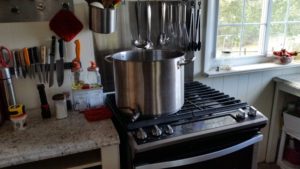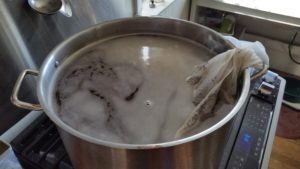Some of the links below are affiliate links, meaning, at no additional cost to you, I will earn a commission if you click through and make a purchase.
My latest brew day was a bit of a departure for me in a number of ways. First, it’s first Irish Red Ale I’ve brewed in over a decade–April 2008 was my last one. Second, I went with a partial-mash kit, done as a brew-in-a-bag (BIAB), which I’ve never done before. Third, due to high winds, I had to brew inside, which I’ve done before, but generally dislike. And lastly, this is my first time using yeast from Omega Labs.
Irish Red Partial-Mash Kit
Keeping with the “start from the basics” progression I’ve been doing the last few brews, I went “intermediate” with this batch, and used a partial-mash kit from MoreBeer. If you’ll recall, the “beginner” process was using extract kits, which took the majority of their maltiness from cans (or, in this case, pouches) of liquid malt extract, getting stylistic accents from a small handful of grains to be steeped.
So-called “partial-mashing” is in between extract brewing and all-grain brewing, in that about half of the fermentables come from extract, while the other half come from grains that have to be “mashed”. The process is simpler than it sounds. In essence, it’s the same thing as steeping the grains in an extract batch, except there are more of them–instead of the 8 ounces or so, I used 5-1/4 pounds of grains. They need to steep for longer, too, and at a slightly more particular temperature: an hour, at about 152 degrees.
Since I moved inside, which complicates using my all-grain equipment (an igloo cooler to hold the steeping grains, mostly), I decided to try the “brew-in-a-bag” method. This is a variation on the partial mashing technique, and with the right setup can be used for all-grain. Like it sounds, I put the crushed grains for this batch in a bag; I then heated up my full volume of liquid in my pot to about 160 degrees, turned off the heat, and added the bag of grains. Then, they steeped.
Another complication with being inside on the stove is that full-volume boils are difficult; compared to my 150,000 BTU burner outside, I’ve got access to something shy of 90,000 BTUs across the three biggest burners of the stove. But I made it work.
Grain Tea
Had this been outside, I would have been more concerned with temperature loss through the kettle. As it was, the temp tried to drop quickly enough that I turned one burner on low, just to maintain things for the hour. Once that finished, I removed the bag, put a cooling rack across the top of the pot, and set the bag of grains on that to drain.
About twenty minutes later, I added the remaining malt (about 4 pounds of extract, in this case), stirred it up to mix it, and turned the burners up to full again. As before, coming up to temperature (a full boil, in this case) took some time, but we got there. Well, let’s call it a “vigorous simmer,” at the least. Eight gallons of liquid is a lot of mass to heat.
Once boiling, the brew proceeded as typical, adding hops at various intervals, stirring things now and again, and keeping an eye out to watch for boilovers, which is particularly important when brewing inside. With the smaller burners of the stove and a full-volume boil, it’s not usually an issue–but in this case, an unwatched pot always boils over.
Finishing Things Up
Having completed the hour-long boil, I gave everything a thorough stir, to get any trub (the “gunk” that forms in the liquid, comprised mostly of coagulated proteins) to pile in the center of the pot, then drained the finished wort into a fermenting bucket. I managed to get 5 gallons of wort at a gravity of 1.059, which was a higher efficiency than I was expecting, but that’s fine. Here again, I was left with a digression from how I like to do things: being indoors, I don’t have access to hoses, which means no wort chillers. So, I did things the old-fashioned way, and put the lid (loosely) on the bucket, set it in the utility room, and left it overnight.
Here again, I was left with a digression from how I like to do things: being indoors, I don’t have access to hoses, which means no wort chillers. So, I did things the old-fashioned way, and put the lid (loosely) on the bucket, set it in the utility room, and left it overnight.
Come the next morning, it had cooled sufficiently, and I was able to pitch the yeast. I’ve not used Omega Yeast Labs in the past; they have liquid yeast in large pouches similar to Wyeast, but without the “smack pack”. Given that the wort wasn’t really high gravity, and it’s “only” 5 gallons, I felt safe enough just using the one packet. If things stall out, or otherwise don’t go well, I’ve got a packet of dry Nottingham yeast to use as a backup.
In all, I’ll probably get about 4.5 gallons of beer, with between 5.75-6% ABV. That’s stronger than I was aiming for, but not by too much. It’s looking like about 47 IBUs, and if my nose is a guide, it’ll be a nicely dry, roasty brew. I think the color of this one is a bit darker than I’d maybe hope for. It’s shaping up to be a deep garnet red, verging towards brown. The grain bill had both black roasted barley and Special B, as well as 120L (dark) crystal malt. Were I building this from scratch, I’d maybe keep the crystal, or more likely use 90L. I’d also use either the black roast or the Special B, but not both. (Most likely, I’d go with the Special B; it gives a nice red color, and has just enough of the roasty coffee-like bitterness, without being overwhelming.) In all, I think it’ll be lovely when it’s done.
For those keeping track, the Irish Red Ale is Batch #171 in my Little Black Book of Brews.
Previous Brews
I keep sipping on the Best Bitter and the English Pale from last month. They’ve been steadily improving, both due to the simple time factor, and from getting a little bit of chill on. Three weeks was a little young to be serving them. Now that they’re going on six weeks, they’re really hitting their stride. And since the kegs have been living on my back patio, and it’s been getting into the 30’s at night, they’ve cold-crashed down to a much better clarity.
That said, I still much prefer the English Pale. The Best Bitter, while better than it was, is still a little too estery for my taste. The English Pale, on the other hand, has developed into something very reminiscent of some of the draughts I had while in England and Scotland. In fact, it puts me in mind of a Fuller’s I once had on cask, and is quite yummy and quaffable.
That’s about it for this time around. I hope to get to more charcuterie in the near future. I also have to wrap up my thoughts on what’s happened with the bees this year, but I’d like to address them soon. As always, if you have any questions, commentary, or suggestions, I’d love to hear them in the comments!
